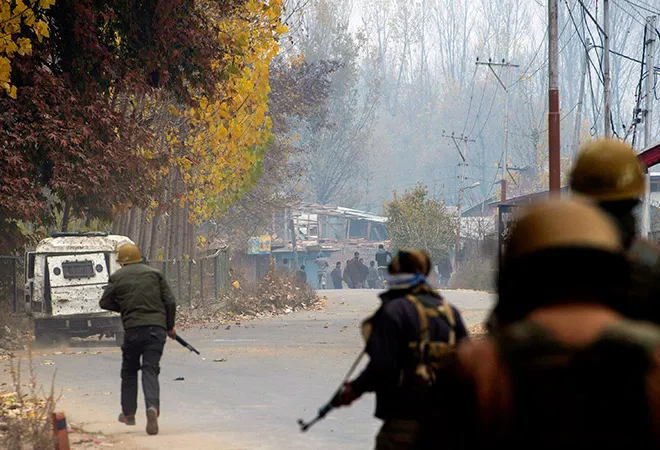The assassination of senior journalist Shujaat Bukhari indicates a tectonic shift underway in Jammu and Kashmir. His killing was the first of its kind, an attack on a senior journalist, that too in the heart of Srinagar. The incidents that have taken place in the Kashmir Valley in the last month — over the last 48 hours in particular — clearly indicate that the situation in the state has slipped from contemporary timelines and is back to the 1990s now.
Bukhari himself was the foremost voice of moderate separatism in Kashmir. Apart from the role he played as a journalist and commentator, he was also passionately involved in the peace-building process and was a true votary of dialogue as a means towards peace. What strikes observers in his case is that such assailants and the groups they are associated with see a threat even in a moderate voiceleaning towards separatism.
On one hand, the incident has left journalists in Kashmir feeling utterly threatened, and many journalists I spoke to after the news of Bukhari’s death broke were feeling deep dread, for obvious reasons. On the other hand, Bukhari’s assassination is not merely the killing of a journalist, but an act of muzzling the very voice of moderation. It is a strong message for others to fall in line. The 'or else' has become brutally clear now.
Of course, the state of Kashmir has witnessed many high-profile assassinations — from the killing of senior Mirwaiz Maulvi Farooq (in May 1990) to that of separatist leader Abdul Ghani Lone (in May 2002), to the attempted assassination of Fazl Ul Haq Qureshi, who survived a brutal attack in December 2009 and the killing of Bukhari now. All these incidents have a common context — most importantly, all these victims were seen as voices of moderation. Bukhari joins the long list of "martyrs" who were known as moderate voices and who strove for peace-building in Kashmir.
Activists in Kashmir live in fear
Bukhari’s assassination has attracted international attention and condemnation, and rightfully so. But there are many other victims who suffer silently. Many of my friends working in mainstream politics and social activism in Kashmir have stopped visiting their homes for fear of the gun owing to their political views. Some of them have not been home for several months. Once in a blue moon, they travel to their native villages in South Kashmir, voyages undertaken in the wee hours of the night, returning well before the hustle and bustle of the day starts. Such people live for ages in government guest houses and cheap hotels, with extended relations and with friends.
But the fear of the gun, of literally being murdered for their views, has made them sacrifice the joy of being with family and experiencing togetherness.
Most importantly, their viewpoints have pushed them into a sense of constant insecurity. They don’t know when an assailant will come at them to pump bullets into them for simply having their individual views. The space for such moderation, and for a mainstream to exist in Kashmir, had shrunk drastically after the killing of former Hizbul Mujahideen commander Burhan Wani in 2016, an event followed by extraordinary threat. Bukhari's murder has now made that space even smaller and the point of no return seem much closer.
Militancy rose despite Ramzan ceasefire
This assassination, however, should not be seen in isolation. The abduction and subsequent killing of Aurangzeb, a solider of the Indian Army hailing from Jammu and Kashmir's Poonch district, shows the confidence and tenacity of militant groups that strike at will. Less than 24 hours after the assassination of the Rising Kashmir editor-in-chief, another bold attack, that too occurring in Srinagar's busy Kaka Sarai area, is yet another indicator of the worsening security situation.
Now, the turn of events over the last 48 hours has made the Ramzan ceasefire untenable.
With the withdrawal of the ceasefire comes the horror of another uncertainty — how the situation will unfold hereon. There is no doubt that counter-offensive operations against militant groups in the Valley will resume after the Eid festivities are over. It has been established through various studies of the police that recent encounters have actually caused an increase in the recruitment of local Kashmiris into the ranks of militant groups — the cycle of encounters and of recruitment will only perpetuate and aggravate the security threats now.
As per reports, as many as 62 terror-related incidents were noted after the Ministry of Home Affairs announced the Non-Initiation of Combat Operations. These include 22 incidents of grenade attacks, 23 cases of firing by militants and six operations initiated by security forces.
Militant groups recruited around 40 more to their ranks despite the ceasefire, according to a report in The Times of India.
In at least five such encounters along the Line of Control (LoC), 15 militants were killed after cross-border infiltration. Despite the volatile situation along the LoC and the exchanges of fire between India and Pakistan, such cross-border infiltration has also only increased.
In another worrying trend, Al Badr — a defunct pan-Islamic militant group — was revived during the ceasefire. The group claimed responsibility for some grenade attacks in the Kashmir Valley during Ramzan. Significantly, it also claimed to have seduced young Kashmiri boys into picking up arms.
Militancy falling back to old patterns
This "new militancy" in Kashmir has started showing trends similar to that of the old militancy of the 1990s. It started with one militant group —the Jammu Kashmir Liberation Front — and eventually spiralled out of control with the involvement of more than a dozen others. Similarly, what started off with one social media post by Wani turned monstrous both in terms of its scale and impact.
Even though the number of active militants is still low in comparison to the numbers seen in the 1990s, these 250-odd combatants have the whole of South Kashmir on edge to the extent that the parliamentary constituency of Anantnag has been vacant since chief minister Mehbooba Mufti left the seat. Bypolls for the seat were called off in the wake of the security situation, and the government has failed to call an election since.
With the brutal killing of mainstream figures like Bukhari, the clearly diminishing space for conventional politics in Kashmir and growing militancy, the question that must be haunting the establishments of both the state and New Delhi is now this: "Is it possible to even hold the 2019 elections in the state of Jammu and Kashmir?"
This commentary originally appeared in Firstpost.
The views expressed above belong to the author(s). ORF research and analyses now available on Telegram! Click here to access our curated content — blogs, longforms and interviews.




 PREV
PREV


